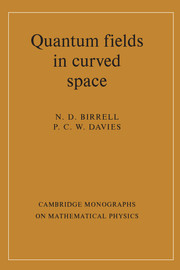Book contents
- Frontmatter
- Contents
- Preface
- Preface to the paperback edition
- Conventions and abbreviations
- 1 Introduction
- 2 Quantum field theory in Minkowski space
- 3 Quantum field theory in curved spacetime
- 4 Flat spacetime examples
- 5 Curved spacetime examples
- 6 Stress-tensor renormalization
- 7 Applications of renormalization techniques
- 8 Quantum black holes
- 9 Interacting fields
- References
- Index
9 - Interacting fields
Published online by Cambridge University Press: 05 August 2012
- Frontmatter
- Contents
- Preface
- Preface to the paperback edition
- Conventions and abbreviations
- 1 Introduction
- 2 Quantum field theory in Minkowski space
- 3 Quantum field theory in curved spacetime
- 4 Flat spacetime examples
- 5 Curved spacetime examples
- 6 Stress-tensor renormalization
- 7 Applications of renormalization techniques
- 8 Quantum black holes
- 9 Interacting fields
- References
- Index
Summary
Once the theory of free quantum fields in curved spacetime had been worked out, the most natural extension was to include the effects of non-gravitational self and mutual interactions. Although this topic is still being developed, the basic framework is well established, and in this final chapter we outline the formal steps necessary for the computation of particle creation effects and the renormalization of 〈Tµν〉.
Two questions immediately spring to mind once interactions are included. The first is to what extent interactions can stimulate or inhibit particle creation by gravity over and above the free field case. Of course, interactions can lead to non-gravitational creation too, but we are more interested in processes that would be forbidden in Minkowski space, such as the simultaneous creation of a photon with an electron–positron pair.
The second question concerns renormalization theory. Will a field theory (e.g. Q.E.D.) that is renormalizable in Minkowski space remain so when the spacetime has a non-trivial topology or curvature? This question is of vital importance, for if a field theory is likely to lose its predictive power as soon as a small gravitational perturbation occurs, then its physical utility is suspect. It turns out to be remarkably difficult to establish general renormalizability, and significant progress has so far been limited to the so-called λϕ4 theory.
A third issue of great interest concerns black hole radiance. Is the Hawking flux precisely thermal even in the presence of field interactions? If not, a violation of the second law of thermodynamics seems possible.
- Type
- Chapter
- Information
- Quantum Fields in Curved Space , pp. 292 - 322Publisher: Cambridge University PressPrint publication year: 1982
- 3
- Cited by



